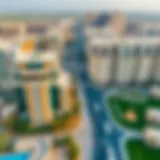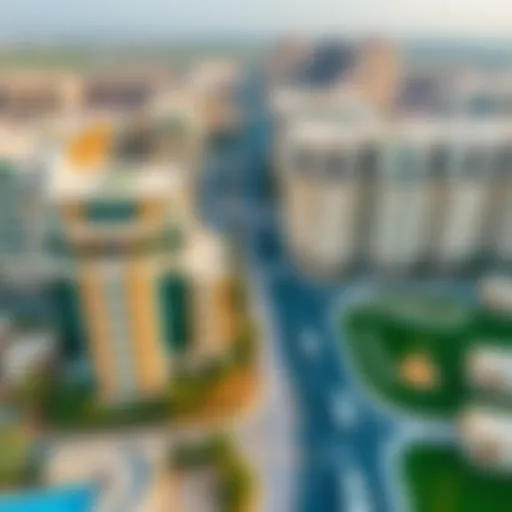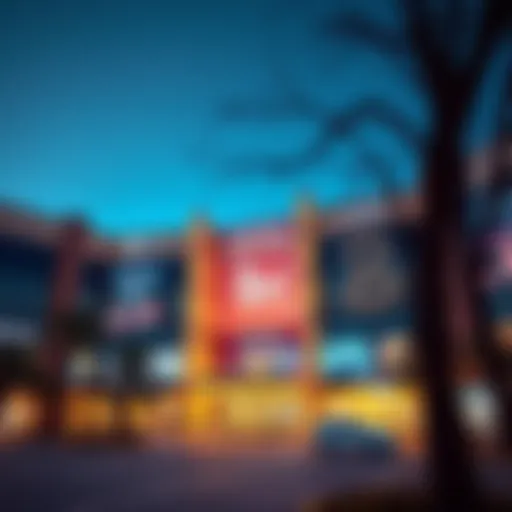Exploring Green Spaces in Dubai: A Comprehensive Guide
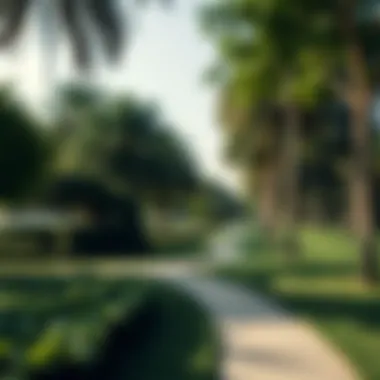

Intro
In the sprawling metropolis of Dubai, green spaces stand as vital lungs, providing a refreshing contrast to the towering skyscrapers and bustling streets. As more people flock to this vibrant city, the need for sustainable environments grows ever clearer. Parks, gardens, and eco-friendly initiatives not only enhance the visual landscape but also contribute to the overall quality of life for residents and visitors alike. The integration of these green areas into Dubai's urban framework plays a crucial role in improving mental well-being, promoting social interaction, and encouraging outdoor activities.
Real estate enthusiasts, investors, and potential buyers should not underestimate the significance of these lush spaces. This guide aims to explore the multifaceted world of Dubai's green environments, while delving into how they affect property values and investment opportunities. By highlighting market trends as well as dissecting the advantages of investing in these flourishing neighborhoods, we aim to equip our readers with substantial knowledge for navigating Dubai's dynamic property market.
"Green spaces are not just decorations; they are essential for sustainable urban life in any modern city."
As we embark on this exploration, a focus will be placed on the current market trends surrounding green spaces and their implications on real estate, before delving into the investment opportunities that lie within this unique facet of Dubai's landscape.
Preface to Dubai's Green Spaces
Dubai, often recognized for its towering skyscrapers and man-made wonders, is also home to a wealth of green spaces that offer not just beauty but a multitude of benefits for residents and visitors. These green areas provide a breath of fresh air in an otherwise bustling metropolis, enhancing the quality of life and contributing significantly to urban sustainability. Exploring these spaces reveals how they serve as essential communal hubs and are pivotal in promoting environmental awareness.
In cities worldwide, green spaces are often seen as vital lifelines—acting as retreats that allow individuals to escape the frenetic pace of urban life. In Dubai, with its hot climate and rapid urbanization, green areas like parks and gardens play an important role in mitigating heat, enhancing air quality, and providing ecosystems for local wildlife. The importance of the topic lies not just in the beautification of the city but also in the tangible benefits these spaces offer to the environment and the community.
The Importance of Green Areas in Urban Settings
Green areas in urban settings facilitate numerous advantages. They offer recreation, social interaction, and health benefits that are critical in a city as dynamic as Dubai. Research shows that individuals who engage with nature experience reduced stress levels, improved moods, and enhanced overall well-being. In a city that often sees extreme temperatures, these areas provide shaded paths and flora that cool the environment.
Moreover, parks serve as meeting points for community events, social gatherings, and cultural celebrations, fostering a sense of belonging and community spirit. They also offer opportunities for people to lead healthier, more active lifestyles through outdoor activities such as walking, jogging, or family picnics. In essence, the greenery amid the concrete not only elevates the city’s aesthetic appeal but also shapes its social fabric.
Dubai's Commitment to Sustainability
Recognizing the pressing need for sustainability in urban development, Dubai has made significant strides toward making its green spaces a focal point in its environmental initiatives. The government has made several pledges to integrate sustainability by incorporating eco-friendly practices in both public and private developments. For instance, initiatives like the Dubai Urban Master Plan have set ambitious goals for increasing green cover within the city.
Additionally, ambitious projects such as the Dubai Vertical Garden showcase the commitment to innovative approaches in sustainable design. The integration of these green spaces into urban planning promotes biodiversity, reduces waste, and encourages conservation efforts.
"Creating a greener Dubai is not just a duty; it's an investment in the well-being of our future generations."
Through various partnerships and programs, Dubai aims to educate and engage the community in sustainable practices, allowing the citizens to take part in the stewardship of these precious green areas. Their efforts extend not just to the present but to the continued resilience of the environment, ensuring that all residents can enjoy vibrant and sustainable spaces for years to come.
Iconic Parks in Dubai
When we talk about the urban fabric of a city like Dubai, the importance of parks cannot be overstated. Iconic parks in this bustling metropolis offer a breath of fresh air amidst the ever-busy lifestyle and concrete jungle. They serve not just as recreational spaces but also as vital ecosystems that contribute to the overall well-being of the residents. These parks are hubs of social interaction, promoting community spirit and offering numerous benefits for real estate development. As investors or developers consider opportunities in Dubai, the proximity to such green areas is an essential factor that can sway buying or leasing decisions.
Zabeel Park
Features and Amenities
Zabeel Park stands out as one of Dubai's most remarkable green spaces. Covering over 45 hectares, it features vast expanses of lawns, vibrant flower beds, and scenic walkways. The park presents ample amenities such as BBQ areas, play zones for children, and an amphitheater that hosts various activities throughout the year. The highlight here? The Dubai Frame, an iconic structure that offers panoramic views of both the old and new parts of the city. This unique feature not only provides a visual treat but also serves as a great spot for social media fans to capture picturesque moments. Such attractions make Zabeel Park a must-visit. However, its sheer size can sometimes lead to larger crowds, particularly during weekends, which might deter those seeking tranquility.
Importance for the Community
Zabeel Park acts as a vital meeting point for families, friends, and fitness enthusiasts. One of its key characteristics is the diverse array of events that are organized here, from cultural festivals to fitness campaigns, which significantly enhance community interaction. The presence of these activities fosters a sense of belonging among residents. Plus, with its accessibility, it becomes a communal resource for all Dubai's citizens, making it a beneficial fixture in the urban environment. However, with increased use, ongoing maintenance is something that the community needs to support, ensuring it remains an inviting space for years to come.
Al Barsha Pond Park
Activities Available
Al Barsha Pond Park is another gem nestled within Dubai's urban sprawl. Known for its family-friendly environment, it boasts a variety of activities, including cycling tracks, jogging paths, and kids' playgrounds. The pond itself is a central feature, where paddle boating is a popular activity among families. It also hosts outdoor movie nights and fitness classes, making it a popular choice for active individuals. The versatility of activities offered ensures that there's something for everyone, which solidifies its status as a sought-after destination.
Natural Wildlife
Beyond the human activities, Al Barsha Pond Park also welcomes a myriad of wildlife. Birdwatchers can spot various species such as herons and ducks, enriching the park's ecosystem. This blend of nature and recreation is vital as it emphasizes sustainable practices in urban settings, reminding visitors that green spaces can thrive amidst cities. However, the presence of wildlife sometimes leads to challenges, like maintaining cleanliness and safety, which requires ongoing community effort.
Dubai Creek Park
Recreational Facilities
Dubai Creek Park is known for its comprehensive recreational facilities, making it a one-stop spot for leisure activities. From picnic areas to bicycle rental services, it has everything needed for a perfect day out. The park also features a cable car that provides a unique vantage point over the creek, which is an exciting experience for both locals and tourists. Such amenities enliven the space and encourage families to spend quality time together in a serene setting. Tho, it may get crowded during festivals, those seeking solitude might find alternative quiet corners.
Scenic Views
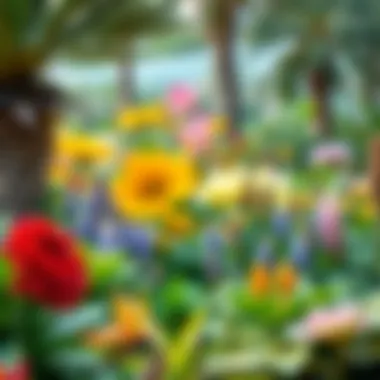

The scenic views at Dubai Creek Park are simply breathtaking. Nestled next to the water, the park offers views that display both natural beauty and Dubai's stirring skyline. Sunset here is magical, casting colors over the creek, making it a preferred spot for evening strolls and photography. This visual aspect dramatically enhances visitors' experiences and is instrumental for real estate advisors to consider, especially as proximity to such views can significantly increase property values. Yet, seasonal wind can sometimes hinder these experiences, especially during the peak of summer when it turns overly hot.
Community Gardens and Urban Farming
The growing movement of community gardens and urban farming in Dubai is a testament to the innovative spirit of its residents. As urbanization marches forward, these green patches provide much-needed breathing room in concrete jungles. They not only contribute to enhancing community engagement but also play a vital role in promoting sustainability, health, and environment.
The Rise of Urban Agriculture
Urban agriculture has taken root in Dubai, fueled by a combination of necessity and passion. With limited space available for traditional farming, local initiatives have embraced the concept of growing food within city limits. This movement is not merely about growing fresh produce, but also about cultivating a sense of community among residents.
One notable aspect of urban agriculture is the focus on organic practices. Many community gardens prioritize organic methods, reducing the need for harmful pesticides and promoting biodiversity. This aligns nicely with the health-conscious mindset of many Dubai residents, making urban farming a smart choice for those seeking fresher ingredients. The rise of farmer's markets, where locals can buy directly from these gardens, highlights the ongoing trend toward supporting local economies.
Notable Community Gardens
Dubai features a few stand-out community gardens, each with unique offerings that contribute significantly to local life. Here are some that stand out:
Educational Initiatives
Educational initiatives within these gardens serve as foundational pillars for cultivating awareness about sustainable practices. They often host workshops focused on topics like organic gardening, composting, and sustainable living. This hands-on learning experience is invaluable as it connects people directly to the issues that affect their environment and health.
- Key Characteristic: These initiatives are highly engaging, drawing both children and adults alike, making learning feel less like a chore and more like a community project.
- Benefits: Engaging in these educational schemes not only fosters environmental responsibility but also enhances the gardening skills of community members.
While these programs offer abundant advantages, it’s important to note that maintaining enthusiasm and participation can sometimes be a challenge. Activities may wane without active promotion or community buy-in.
Community Involvement
The lifeblood of community gardens lies in the active participation of local residents. Community involvement often includes volunteer days, events, and even regular meetings to discuss upcoming projects. This degree of participation strengthens social ties, creating neighborhoods that are more cohesive and friendly.
- Key Characteristic: The aspect of shared ownership fosters a profound respect for the gardens, as every participant has a stake in their upkeep and success.
- Benefits: In addition to improving community spirit, involvement in these gardens can enhance mental well-being through social interaction and physical activity.
However, a unique challenge surfaces when trying to balance diverse opinions and ideas among community members, meaning effective communication is a must. It’s crucial for communities to embrace differences to ensure the smooth operation of these gardens.
Overall, community gardens and urban farming initiatives in Dubai are not just about growing plants; they’re about growing connections. As residents come together to cultivate these spaces, they also cultivate friendships, knowledge, and a collective commitment to a greener future.
Nature Reserves and Protected Areas
Nature reserves and protected areas are essential components of Dubai's commitment to sustain its rich environmental heritage. These areas not only protect diverse ecosystems but also provide essential services that benefit urban populations. Fostering a connection with nature in an often fast-paced urban environment like Dubai can significantly enhance the quality of life for its residents.
Ramsar Sites in Dubai
Significance of Wetlands
Wetlands are vital ecosystems that serve multiple purposes. In Dubai, the significance of wetlands stretches beyond mere beauty. They play a crucial role in water purification, flood protection, and providing habitat for various species. For city dwellers, these wetland areas offer a rare opportunity to engage with nature, contributing positively to mental and physical well-being.
Notably, the interconnectedness of the city's wetlands illustrates effective natural flood management. They can absorb excess rainwater, reducing the risk of urban flooding – a common issue in many cities. This makes them a particularly beneficial feature in Dubai's landscape, as they harmonize environmental needs with urban demands.
Beyond practical benefits, wetlands also create lush habitats for various wildlife, supporting biodiversity in a way that stark urban landscapes cannot. Their unique ability to buffer environmental stressors makes them indispensable. The overall beauty and ecological balance they maintain are unrivaled, positioning them as a conservation priority.
Biodiversity
Biodiversity within these protected areas carries immense significance in sustaining ecosystem resilience. Rich biodiversity boosts ecological stability. In Dubai's context, this notion translates into various species thriving, ensuring a balanced ecosystem.
A key characteristic of biodiversity is its ability to offer a range of ecosystem services – including pollination, nutrient cycling, and climate regulation. By protecting biodiverse areas, Dubai reinforces its commitment to global conservation goals. Additionally, these vibrant ecosystems serve as natural laboratories where researchers can study sustainability in real time.
Moreover, diverse ecosystems attract various visitors, from researchers to nature enthusiasts. However, promoting biodiversity comes with challenges; increased human activity can put pressure on these delicate habitats. Balancing visitor access with preservation efforts is critical to maintaining their ecological integrity.
Dubai Desert Conservation Reserve
Conservation Efforts
The conservation efforts in Dubai Desert Conservation Reserve exemplify a successful framework for sustainable environmental practices. It’s not just about preserving landscapes; it's integral to safeguarding endangered species and promoting native vegetation. These conservation programs play a significant role in maintaining the ecological balance and reinforcing the connection between residents and their environment.
An essential aspect of these efforts focuses on educating the public about the importance of conservation. Through such initiatives, communities engage more deeply with their surroundings, fostering stewardship. For many, understanding the role of these areas in maintaining the desert's delicate ecosystem can change perspectives and instill a sense of responsibility towards environmental sustainability.
One unique feature of these conservation efforts is the emphasis on integrating cultural heritage with natural preservation. By showcasing traditional ways of wildlife management, the reserve not only protects the environment but also enriches cultural narratives. However, these measures must continuously adapt to the changing climate and urban encroachment.


Public Engagement
Public engagement proves to be a foundational element of successful conservation efforts in Dubai. By involving the community, the sense of connection to nature strengthens, fostering a collective responsibility for sustaining these vital areas. Workshops, guided tours, and educational programs cultivate a culture of appreciation for environmental issues.
The characteristic of public engagement here is its interactive nature, appealing to various demographics. From school programs to family excursions, these engagements bring forward a diverse audience, further creating a ripple effect of awareness across the city.
Yet, challenges remain. Maintaining consistent interest and enthusiasm can be tough in a rapidly transforming city. Over time, strategies need to evolve to keep the community connected with nature and aware of their role in conservation. One unique feature of this engagement is utilizing modern technology, such as mobile apps for citizen science initiatives, which enable the public to participate actively in monitoring local wildlife.
"In protecting nature, we protect ourselves. The future depends on the collective actions we take today."
Ultimately, nature reserves and protected areas like the Ramsar sites and the Dubai Desert Conservation Reserve represent not only the ecological diversity of the region but also the city's commitment to sustainable urban living. These areas underscore the essential relationship between nature and urban life, providing a framework for what a thriving city can look like.
Dubai's Botanical Gardens
Dubai's botanical gardens represent an essential facet of the city’s commitment to sustainability and beautification. Not only do these gardens beautify urban spaces, they also play a crucial role in promoting biodiversity, educating the public about different plant species, and enhancing the quality of life for residents. Offering a blend of leisure and education, these areas offer urban dwellers a chance to connect with nature amidst a bustling metropolis.
Dubai Miracle Garden
A Floral Wonderland
The Dubai Miracle Garden stands as a beacon of creativity and commitment to horticulture. Covering over 72,000 square meters, it is the world’s largest natural flower garden, boasting upwards of 150 million blooming flowers. One cannot help but be impressed by its vibrant colors and imaginative designs. The key characteristic of this garden is its artistic landscape, showcasing stunning floral sculptures and themed displays, such as a life-sized Emirates A380 airplane, entirely adorned with flowers. This unique feature attracts visitors not just for its aesthetics but brings to light the importance of planting in urban settings. Its advantages lie in its ability to provide a serene escape, exemplifying nature’s beauty in a desert environment, while its disadvantages may include the maintenance challenges that arise in such vast floral displays.
Visitor Experience
The Visitor Experience at the Dubai Miracle Garden is designed to be immersive and memorable. Guests can wander through the various sections, each offering unique sights and fragrances. A key highlight is the well-organized layout that allows for easy navigation and plenty of photo opportunities. This makes the garden a popular choice for tourists and locals alike, drawing people looking for an escape from the concrete landscape of the city.
One of the unique aspects of the Visitor Experience is the various interactive exhibits and events held throughout the year, which enhance educational engagement. However, during peak seasons, the high volume of visitors can detract from the tranquil atmosphere everyone seeks.
The Garden at the Els Club
Eco-Friendly Design
The Garden at the Els Club showcases a dedication to Eco-Friendly Design, integrating sustainability with luxury. This garden features native plant species that require minimal irrigation, aligning with Dubai’s broader environmental goals. What sets this garden apart is its incorporation of green technologies, like drip irrigation systems and organic gardening practices. The benefit of such design is not only environmental conservation but also cost efficiency in maintenance. However, its location at a golf club may limit access for the general public, which could detract from its community impact.
Networking Events
Networking events at The Garden at the Els Club provide an opportunity for professionals to mingle in a refreshing and greenery-filled environment. These events are crafted to foster connections while enjoying the tranquility offered by the lush surroundings. A standout characteristic of these gatherings is their exclusivity, often attracting a high-caliber group of business professionals and investors, making it a beneficial choice for those seeking to expand their network. The unique feature of this setting is undoubtedly its picturesque backdrop, turning a simple meeting into an inspiring experience. However, the challenge may lie in the high costs associated with hosting events in such premium environments, which could limit attendance.
Ultimately, Dubai’s botanical gardens, including the Dubai Miracle Garden and The Garden at the Els Club, are transforming how residents and visitors interact with nature in an urban landscape. They serve not only as breathtaking attractions but also as vital educational and environmental hubs.
Government Initiatives for Green Living
The debate surrounding environmental sustainability is more pertinent today than ever, especially in rapidly urbanizing regions like Dubai. The government of Dubai is taking significant steps to promote green living, emphasizing the creation and maintenance of numerous green spaces across the city. This initiative not only fosters ecological balance but also enriches the quality of life for its residents. These government strategies help balance rapid development with environmental stewardship, enhancing the overall urban environment.
Dubai Green Economy Partnership
The Dubai Green Economy Partnership was established to support the emirate's transition towards a sustainable economy. This initiative highlights the collaboration between various sectors, pushing forward the agenda of environmental sustainability. The partnership plays a pivotal role in promoting investment in renewable energy, enhancing energy efficiency, and, most significantly, expanding the green spaces within the city.
For instance, by encouraging private and public sectors to invest in parks and urban gardens, the government aims to bolster not just aesthetic appeal, but also the mental and physical wellbeing of the population. Green spaces serve as lungs for the city, absorbing pollutants and providing a habitat for urban wildlife, which in turn fosters biodiversity.
Such partnerships encourage local businesses to partake in eco-friendly practices. Initiatives include workshops and training programs to educate community members about sustainable living. The impact can be multifaceted—ranging from improved public health to an uptick in property values due to proximity to these green areas.
Sustainable Architecture in New Developments
As urban landscapes continue to expand, the need for sustainable architecture in new developments becomes essential. The Dubai government encourages integrating eco-friendly practices in building designs, ensuring that these constructions align with the vision of a greener city. For instance, new developments are increasingly built with energy-efficient materials and designs that maximize natural light and minimize the urban heat island effect.
Moreover, there are increasing instances where residential complexes feature green roofs and vertical gardens, providing not only an aesthetic piece but also functional benefits such as improved air quality and reduced heat retention. This thoughtful integration of landscaping into architecture encourages a symbiotic relationship between built environments and green spaces.
On top of the structural aspects, sustainability in architecture also promotes social sustainability. By fostering community spaces where residents can connect with nature, enhancing community ties and social interactions are achievable. From walkable neighborhoods to communal gardens, these design principles address not just aesthetic beauty but also service functionality.
Investing in sustainable architecture is crucial for future-proofing developments against environmental regulations, while also appealing to sustainability-conscious buyers.
The combination of the Dubai Green Economy Partnership and the emphasis on sustainable architecture in new developments reveals a comprehensive approach to creating livable, environmentally friendly spaces in the urban fabric of Dubai. It showcases how the government’s initiatives are not merely policies on paper, but actively transforming Dubai into a greener city, benefiting residents and investors alike.
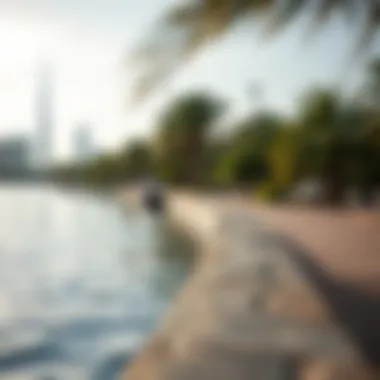

The Role of Green Spaces in Real Estate
The role of green spaces in real estate is more important than many realize. In fast-paced cities like Dubai, where steel and glass dominate the skyline, these pockets of greenery play a crucial role in enhancing urban living. They not only serve as escape routes from the hustle and bustle but also substantially influence property values, buyer interest, and overall neighborhood desirability.
Impact on Property Values
Market Analysis
Market analysis is key to understanding how green spaces contribute to property values. Properties adjacent to parks or gardens often fetch higher prices. This trend is tied to factors like increased demand for areas that promote well-being and sustainability. Buyers today, especially millennials and Gen Z, prioritize living in environments that enrich their lifestyle and health.
Key characteristics of market analysis include:
- Data-driven insight: Learning how proximity to green areas boosts property worth can drive investment strategies.
- Comparative studies: Evaluating neighborhoods with and without green spaces reveals valuable trends, affirming the benefit of investing in green-centric locations.
- Market demand: A growing preference for eco-friendly living spaces has made areas with lush landscapes more appealing, shaping a lucrative segment for property developers.
Unique features of this approach include:
Market analyses can reveal both the positive and negative impacts of green spaces. While proximity often translates to higher values, maintenance and design of these areas play a significant role in their perceived value.
Case Studies
Case studies offer practical insights into the impact of green spaces on property values. For instance, developing areas around Dubai Marina and Jumeirah have invested heavily in creating parks and waterfront views, resulting in skyrocketing real estate prices. These examples underscore how successful integration of greenery can transform neighborhoods.
Key characteristics of case studies include:
- Real-world application: They provide quantifiable data showing the correlation between green spaces and property valuation over time.
- Success stories: Areas that have revitalized through enhanced landscaping often tell compelling stories of increased community engagement and economic growth.
Unique advantages of case studies:
They allow real estate professionals to learn from successful implementations, showing that well-planned green spaces can revitalize neighborhoods, thereby attracting higher bids from potential buyers.
Attracting Investors and Buyers
Green spaces also play a pivotal role in attracting investors and buyers. A real estate project that incorporates parks, gardens, and other greenery tends to attract those who value an environmentally conscious lifestyle. More buyers are willing to pay a premium for properties that offer peaceful retreats from urban life.
- Health benefits: Access to green spaces is associated with improved mental and physical health, making properties in these locations alluring for families and individuals alike.
- Community vibe: Parks promote social interactions, encouraging a sense of community that buyers find highly desirable.
- Long-term value: Investing in properties near green spaces is increasingly seen as a hedge against market volatility, as these areas tend to retain their appeal over time.
As Dubai continues to expand, the integrating of green spaces in urban development will likely remain a significant driver of real estate trends, shaping buyer preferences and investment strategies.
"The true beauty of a city is often found in its green spaces, reflecting the balance between nature and urban life."
Future of Green Spaces in Dubai
As Dubai strides towards a sustainable future, the significance of green spaces grows beyond mere aesthetics. They play a pivotal role in balancing urbanization with nature, which is vital for the well-being of residents and the environment alike. As the city expands, staying attuned to how these spaces evolve is crucial for real estate developers, investors, and anyone interested in quality urban living. Understanding this trajectory helps to outline not only potential property value increases but also improves the overall quality of life in a bustling metropolis.
Emerging Trends in Urban Development
Urban development in Dubai has been taking innovative turns, especially focusing on creating multifunctional green spaces.
- Mixed-Use Developments - Projects that combine residential, commercial, and recreational areas are becoming the norm. Such designs promote walkability and accessibility to green spaces, allowing residents to immerse themselves in nature without straying far from their daily necessities.
- Vertical Gardens - As land becomes a premium, developers are turning to vertical gardens as a creative use of space. These gardens not only enhance building facades but also contribute to biodiversity and air quality in densely populated urban areas.
- Public-Private Partnerships - Collaborations between governmental bodies and private enterprises are essential for the development and maintenance of green spaces. These partnerships ensure that facilities such as parks and gardens are well-funded and cared for, promoting long-term sustainability.
- Community-Centric Projects - There’s a rising trend toward involving the community in the planning and upkeep of public areas. Engaging local residents means that the green spaces meet actual needs and fosters a sense of ownership and responsibility.
Integration of Technology in Green Initiatives
Technology is reshaping how green spaces are developed and maintained in Dubai, bringing efficiency and sustainability to the forefront.
- Smart Irrigation Systems - By utilizing moisture sensors and weather data, these systems optimize water usage, helping to conserve this precious resource in the arid environment of Dubai.
- Environmental Monitoring - Apps and tools that track green space usage can provide data on visitor numbers, maintenance needs, and overall health of green areas, guiding future improvements.
- Urban Heat Island Mitigation - By implementing technology in urban design, such as heat-reducing materials and cooling foliage, Dubai is actively working to combat the heat island effect. This is particularly important in a city where temperatures can soar.
- Eco-friendly Infrastructure - Initiatives include green roofs and rain gardens. These not only beautify the landscape but also serve to absorb rainwater, reducing runoff and improving urban drainage.
"As technology advances, the ways in which we interact with, maintain, and expand our green spaces will shift, making them more resilient against climate challenges."
Epilogue
As we draw the curtain on our exploration of Dubai's green spaces, it's clear these lush areas are about so much more than just greenery. They represent the city's commitment to sustainable living, offering residents and visitors vibrant spots to unwind amidst the hustle of urban life.
Recap of Key Points
In this guide, we've delved into several key topics regarding Dubai's green initiatives:
- Iconic Parks: Zabeel Park, Al Barsha Pond Park, and Dubai Creek Park not only provide recreational options but also enhance community well-being.
- Community Gardens: The rise of urban agriculture has reshaped notions of food production, linking residents through initiatives that foster engagement and education.
- Nature Reserves: Ramsar sites and the Dubai Desert Conservation Reserve illustrate the importance of biodiversity and global ecological responsibilities.
- Botanical Gardens: Spaces like Dubai Miracle Garden showcase natural beauty while promoting eco-friendly practices.
- Government Initiatives: Dubai’s dedication to a green economy is apparent through various partnerships and sustainable building projects.
- Role in Real Estate: Green spaces significantly impact property values, drawing in investors and buyers seeking quality living environments.
The Path Ahead for Dubai's Green Spaces
Looking forward, the future of green spaces in Dubai is filled with potential. The city’s trajectory towards integrating more parks and gardens is promising. Emerging trends hint towards enhanced connectivity between these spaces and urban development. As technology interweaves into green initiatives—think smart irrigation systems and eco-monitoring—Dubai is set to become a beacon for sustainable urban living.
It’s essential to consider that as green spaces evolve, they’ll continue to foster community ties and improve overall quality of life. Investing in these areas not only contributes to personal well-being but also to the broader vision of sustainability in Dubai's urban fabric.
The blend of nature and urbanization is vital, creating a livable, resilient city for future generations.
